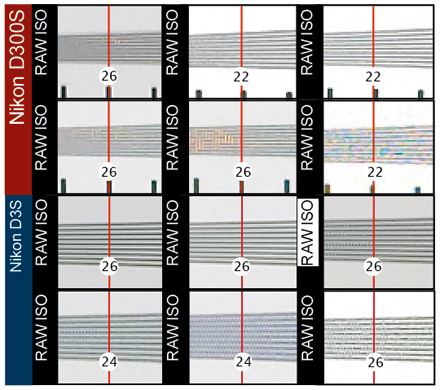Sony Alpha 550 APS-C vs Sony Alpha 850 full frame camera

Although it has a full-frame sensor, the Sony Alpha 850 has an effective pixel count of 24.6 million, so the imaging device is crowded with tiny photoreceptors. While this enables the camera to record an enormous amount of detail and resolve lines further along our resolution chart than almost any other camera, the tiny photosites only generate a weak signal and consequently high-sensitivity images are very noisy.
However, high-sensitivity images taken on the Alpha 850 still have less noise than those captured by the 14.2-million-pixel Alpha 550. It’s not really surprising that Sony has capped the Alpha 850’s sensitivity at ISO 6400, but the Alpha 550’s sensitivity range may be set as high as ISO 12,800.
You can expect to see plenty of chroma noise in the Alpha 550’s raw files captured at the highest sensitivity settings, and although there is also a reasonable amount of detail visible, prints are best kept to A4 or smaller.
Naturally, the lower pixel count of the Alpha 550 means it isn’t able to resolve as much detail as the Alpha 850, but it gives a reasonable account of itself in our resolution tests. However, its performance is marred by mirror-slap, which causes blurring even when the camera is mounted on a tripod.
Nikon D300S APS-C vs D3S full frame camera

The Nikon D300S and D3S are closely related, and although one has an APS-C-sized sensor and the other has a full-frame device they have a great deal in common.
The D3S demonstrates what is currently possible with a 12.1-million-pixel full-frame sensor; our tests reveal that it controls noise exceptionally well, even at very high-sensitivity settings.
Consequently, Nikon has set the highest native sensitivity setting to ISO 12,800, but this may be expanded a further 3 stops to the equivalent of ISO 102,400. Noise levels are comparatively high at this setting, but it means the camera is able to operate in light levels that previously required specialist infrared kit.
While the D300S is an excellent camera, its smaller sensor has almost the same pixel count (12.3 million) as the full-frame D3S and, as a consequence, noise becomes noticeable lower down the sensitivity range. At ISO 1600, for instance, images from the D300S have about the same amount of noise as those taken at ISO 12,800 on the D3S. Although their pixel count is very similar, the D3S’s low noise levels enables it to record a little more detail than the D300S, but the difference is not dramatic and the D300S is very capable.




